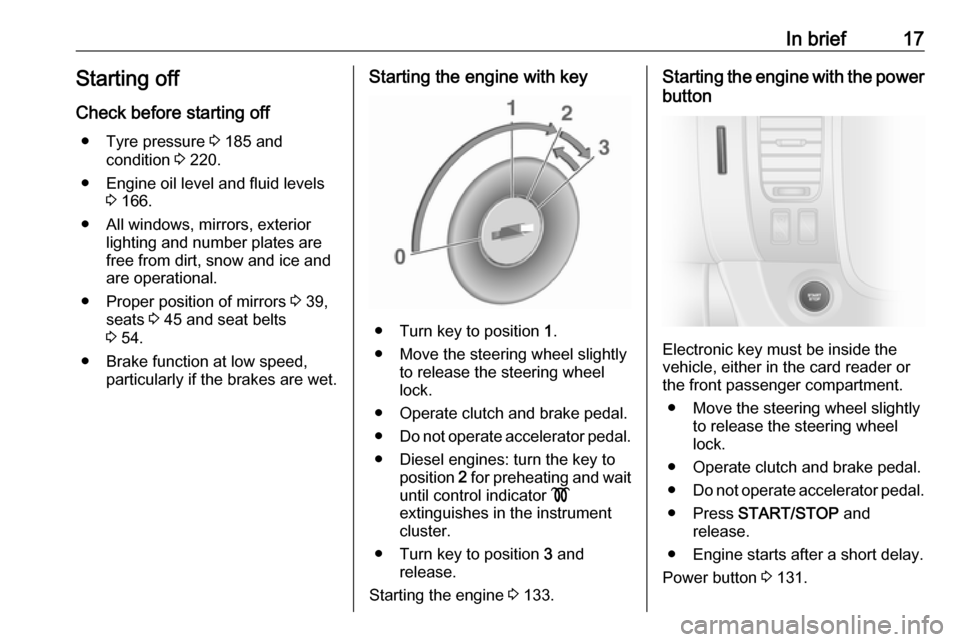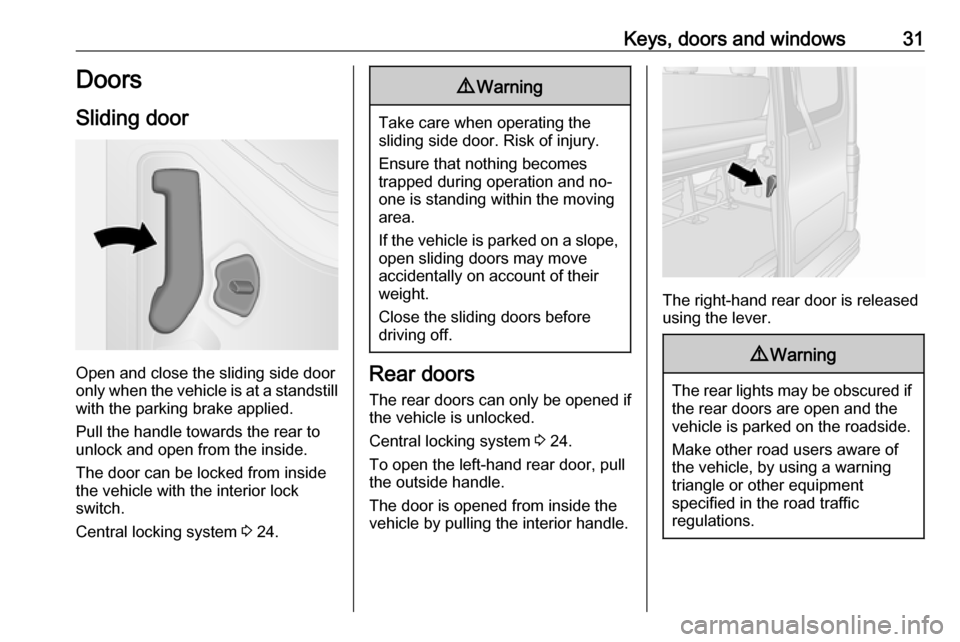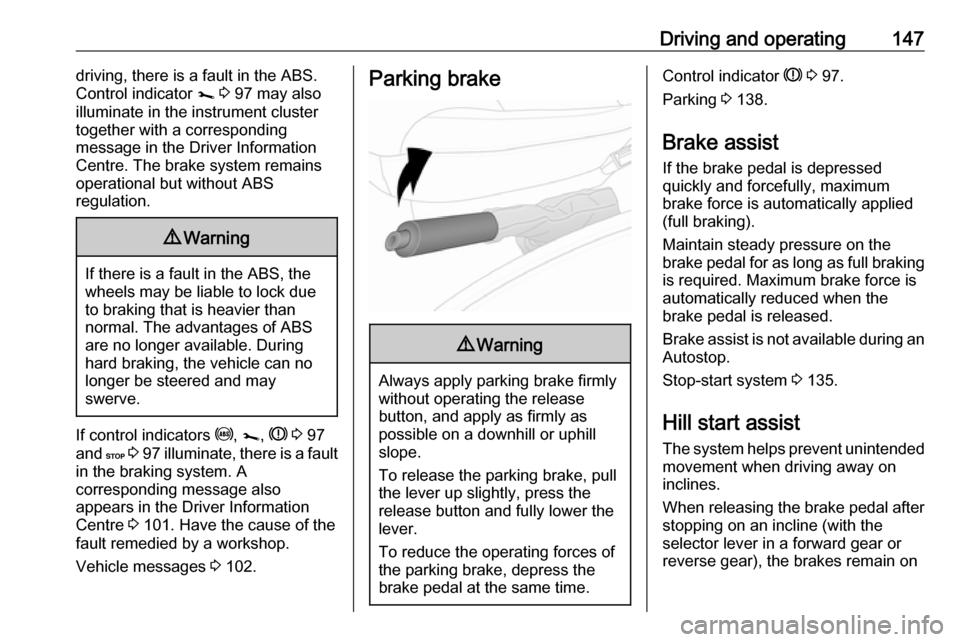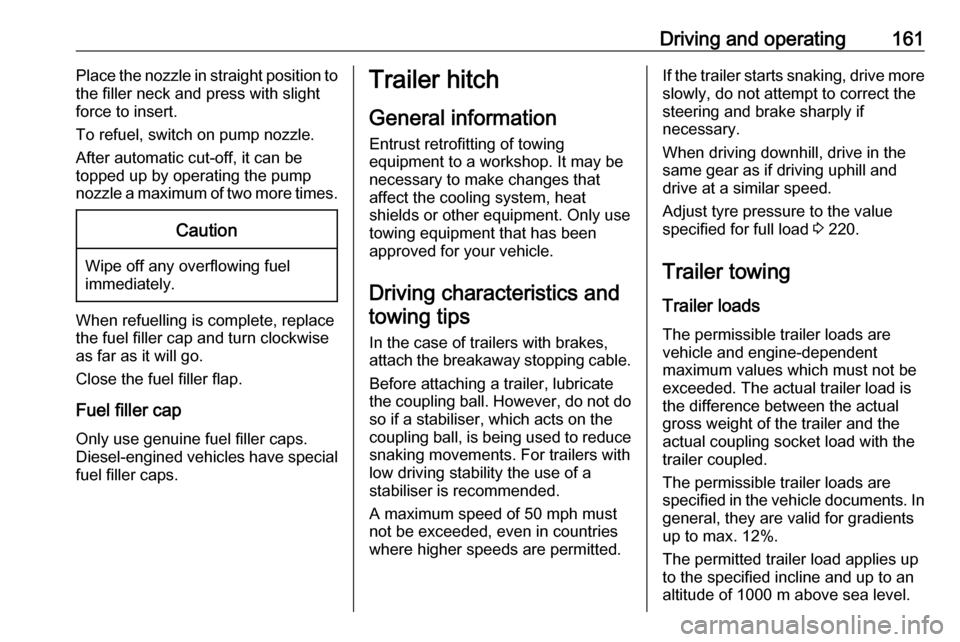brake light VAUXHALL VIVARO 2018.5 Owner's Manual
[x] Cancel search | Manufacturer: VAUXHALL, Model Year: 2018.5, Model line: VIVARO, Model: VAUXHALL VIVARO 2018.5Pages: 239, PDF Size: 5.75 MB
Page 19 of 239

In brief17Starting offCheck before starting off ● Tyre pressure 3 185 and
condition 3 220.
● Engine oil level and fluid levels 3 166.
● All windows, mirrors, exterior lighting and number plates are
free from dirt, snow and ice and
are operational.
● Proper position of mirrors 3 39,
seats 3 45 and seat belts
3 54.
● Brake function at low speed, particularly if the brakes are wet.Starting the engine with key
● Turn key to position 1.
● Move the steering wheel slightly to release the steering wheel
lock.
● Operate clutch and brake pedal. ● Do not operate accelerator pedal.
● Diesel engines: turn the key to position 2 for preheating and wait
until control indicator !
extinguishes in the instrument
cluster.
● Turn key to position 3 and
release.
Starting the engine 3 133.
Starting the engine with the power
button
Electronic key must be inside the
vehicle, either in the card reader or
the front passenger compartment.
● Move the steering wheel slightly to release the steering wheel
lock.
● Operate clutch and brake pedal.
● Do not operate accelerator pedal.
● Press START/STOP and
release.
● Engine starts after a short delay.
Power button 3 131.
Page 33 of 239

Keys, doors and windows31Doors
Sliding door
Open and close the sliding side door
only when the vehicle is at a standstill
with the parking brake applied.
Pull the handle towards the rear to
unlock and open from the inside.
The door can be locked from inside
the vehicle with the interior lock
switch.
Central locking system 3 24.
9 Warning
Take care when operating the
sliding side door. Risk of injury.
Ensure that nothing becomes
trapped during operation and no-
one is standing within the moving
area.
If the vehicle is parked on a slope,
open sliding doors may move
accidentally on account of their
weight.
Close the sliding doors before
driving off.
Rear doors
The rear doors can only be opened if
the vehicle is unlocked.
Central locking system 3 24.
To open the left-hand rear door, pull the outside handle.
The door is opened from inside the
vehicle by pulling the interior handle.
The right-hand rear door is released
using the lever.
9 Warning
The rear lights may be obscured if
the rear doors are open and the
vehicle is parked on the roadside.
Make other road users aware of the vehicle, by using a warning
triangle or other equipment
specified in the road traffic
regulations.
Page 84 of 239

82Instruments and controlsInstruments and
controlsControls ....................................... 83
Steering wheel adjustment ........83
Steering wheel controls .............83
Horn ........................................... 83
Steering column controls ...........83
Windscreen wiper and washer ..84
Rear window wiper and washer ...................................... 85
Outside temperature ..................85
Clock ......................................... 86
Power outlets ............................. 87
Cigarette lighter ......................... 88
Ashtrays .................................... 88
Warning lights, gauges and indi‐ cators ........................................... 89
Instrument cluster ......................89
Speedometer ............................. 89
Odometer .................................. 90
Trip odometer ............................ 90
Tachometer ............................... 90
Fuel gauge ................................ 90
Fuel economy gauge .................91
Service display .......................... 92
Control indicators ......................92Turn lights.................................. 95
Seat belt reminder .....................96
Airbag and belt tensioners .........96
Airbag deactivation ....................96
Charging system .......................97
Malfunction indicator light ..........97
Service vehicle soon .................97
Stop engine ............................... 97
Brake system ............................. 97
Antilock brake system (ABS) .....98
Upshift ....................................... 98
Electronic Stability Program ......98
Electronic Stability Program off ............................................. 98
Engine coolant temperature ......98
Preheating ................................. 99
AdBlue ....................................... 99
Tyre pressure monitoring system ...................................... 99
Engine oil pressure ....................99
Fuel economy mode ................100
Low fuel ................................... 100
Stop-start system ....................100
Exterior light ............................ 100
High beam ............................... 100
Fog light ................................... 101
Rear fog light ........................... 101
Cruise control .......................... 101
Speed limiter ........................... 101Tachograph............................. 101
Door open ................................ 101
Displays ..................................... 101
Driver Information Centre ........101
Info Display .............................. 102
Vehicle messages ......................102
Warning chimes .......................103
Engine oil level ........................ 104
Trip computer ............................. 104
Tachograph ................................ 106
Page 97 of 239

Instruments and controls95Control indicators in the roof
console
Overview
OTurn lights 3 95XSeat belt reminder 3 96vAirbag and belt tensioners
3 96Ó ONAirbag activation 3 96* OFFAirbag deactivation 3 96pCharging system 3 97ZMalfunction indicator light
3 97jService vehicle soon 3 97CStop engine 3 97RBrake system 3 97uAntilock brake system (ABS)
3 98kjUpshift, downshift 3 98RElectronic Stability Program
3 98ØElectronic Stability Program
off 3 98WEngine coolant temperature
3 98!Preheating 3 99YAdBlue 3 99wTyre pressure monitoring
system 3 99IEngine oil pressure 3 99ECOFuel economy mode 3 100YLow fuel 3 100DAutostop (Stop-start system)
3 100\Autostop inhibited (Stop-
start system) 3 1009Exterior light 3 1008Exterior light 3 100CHigh beam 3 100>Fog light 3 101øRear fog light 3 101mCruise control 3 101USpeed limiter 3 101&Tachograph 3 101yDoor open 3 101
Turn lights
O flashes green.
Flashes if a turn light or the hazard
warning flashers are activated.
Rapid flashing: failure of a turn light or associated fuse.
An audible warning can be heard
when the turn lights are on.
Bulb replacement 3 174.
Fuses 3 180.
Page 99 of 239

Instruments and controls97Charging system
p illuminates red.
Illuminates briefly when the ignition is switched on.
Illuminates when the engine is
running
If control indicator p illuminates
when the engine is running (together
with control indicator C and a
warning chime): Stop, switch off
engine.
Vehicle battery is not charging.
Engine cooling may be interrupted.
Power to the brake servo unit may be
cut. Seek the assistance of a
workshop.
Malfunction indicator light Z illuminates or flashes yellow.
Illuminates briefly when the ignition is
switched on.Illuminates when the engine is
running
Fault in the emission control system. The permitted emission limits may be exceeded. Seek the assistance of a
workshop immediately.
Flashes when the engine is
running
Fault that could lead to catalytic
converter damage. Ease up on the
accelerator until the flashing stops.
Seek the immediate assistance of a
workshop.
Service vehicle soon j illuminates yellow.
Illuminates briefly when the ignition is
switched on.
May illuminate together with other
control indicators and a
corresponding message in the Driver
Information Centre 3 101. Seek the
assistance of a workshop
immediately.Stop engine
C illuminates red.
Illuminates briefly when the ignition is
switched on.
Illuminates together with other control indicators (e.g., p, I and R),
accompanied by a warning chime and a corresponding message in the
Driver Information Centre 3 101:
stop engine immediately and seek the
assistance of a workshop.
Brake system
R illuminates red.
Illuminates after the ignition is
switched on if the parking brake is
applied 3 147 and extinguishes
when the parking brake is released.
Illuminates when the parking brake is released if the brake fluid level is too
low 3 169.9 Warning
Stop. Do not continue your
journey. Consult a workshop.
Page 102 of 239

100Instruments and controlsIlluminates when the engine is
running
If control indicator I illuminates
when the engine is running (together
with control indicator C and a
warning chime): Stop, switch off
engine.Caution
Engine lubrication may be
interrupted. This may result in
damage to the engine and / or
locking of the drive wheels.
1. Depress clutch.
2. Select neutral gear (or move selector lever to N).
3. Move out of the flow of traffic as quickly as possible without
impeding other vehicles.
4. Switch off ignition.
9 Warning
When the engine is off,
considerably more force is needed
to brake and steer.
Do not remove key until vehicle is stationary, otherwise the steeringwheel lock could engage
unexpectedly.
Check oil level before seeking
assistance of a workshop 3 166.
Fuel economy mode
ECO illuminates green when ECO
mode is engaged to reduce fuel
consumption.
ECO mode, driving economically
3 129.
Low fuel Y illuminates yellow.
Illuminates briefly when the ignition is
switched on.
Illuminates when level in fuel tank is
low (range of approx. 30 miles). Refuel immediately 3 159.
Catalytic converter 3 139.
Diesel fuel system bleeding 3 172.
Stop-start system D illuminates when engine is in an
Autostop.
\ illuminates when an Autostop is
inhibited when certain conditions are
not fulfilled.
Stop-start system 3 135.
Exterior light
9 illuminates green.
Illuminated when the headlights are
on.
8 illuminates green.
Illuminated when the sidelights are
on.
Lighting 3 108.
High beam
P illuminates blue.
Illuminated when high beam is on and during headlight flash 3 109.
Page 105 of 239

Instruments and controls103automatically and j remains
illuminated. The fault will then be
stored in the on board system.
Warning messages
Warning messages regarding, e.g.
engine, battery or brake system
failure, are displayed together with
control indicator C and may be
accompanied by a warning chime.
Stop engine immediately and seek
the assistance of a workshop.
Warning messages, e.g. " BATTERY
CHARGING FAULT " disappear from
the display automatically when the cause of the fault has been remedied.
Fuel economy messages
Fuel economy messages provide tips to improve fuel efficiency. Journeys
can be saved in the system memory,
enabling you to compare
performances.
Refer to Infotainment manual for
further information.
Fuel economy rating 3 104.Warning chimes
If several warnings appear at thesame time, only one warning chime
will sound.
When starting the engine or whilst driving:
The warning chime regarding
unfastened seat belts has priority
over any other warning chime.
● If seat belt is not fastened 3 53.
● If the parking assist detects an object 3 154.
● If the vehicle speed briefly exceeds a set limit 3 151,
3 153.
● If a door or the bonnet is not properly closed when vehicle
exceeds a certain speed.
● During activation and deactivation of alarm monitoring
of vehicle inclination 3 36.
● If there is a fault in the brake system 3 97.
● If the vehicle battery is not charging 3 97.● If engine lubrication is interrupted
3 99.
● If AdBlue needs to be refilled or a
fault is present 3 140.
● If the electronic key is outside of the detection range.
Electronic key system 3 21.
Power button 3 131.
When the vehicle is parked and / or the driver's door is opened:
● If the key has been left in the ignition.
● If the electronic key has been left
in the card reader.
Electronic key system 3 21.
Power button 3 131.
● If the vehicle is in an Autostop. Stop-start system 3 135.
● If the exterior lights are on 3 108.
Page 134 of 239

132Driving and operatingIf the electronic key is not inside the
vehicle, a corresponding message appears in the Driver Information
Centre 3 101.
Notice
Do not put the electronic key in the
load compartment during driving, as
this is outside of the detection zone
(indicated by a warning chime at low
speed 3 103 and a message in the
Driver Information Centre 3 102).
Notice
In the event the electronic key is kept in the front passenger compartment
and a message appears in the Driver
Information Centre (possibly
accompanied by a warning chime)
indicating that it is out of reception
range, we recommend inserting the
electronic key in the card reader.
Some functions, e.g. Infotainment
system, are available for use as soon
as you enter the vehicle.Accessory power mode
Press START/STOP without
operating clutch or brake pedal to
enable further electrical functions to
be operated.
These functions switch off
automatically after a delay.
Engine start
Operate clutch and brake pedal and press START/STOP . Release button
after starting procedure begins.
If a gear is engaged, the engine can
be started only by operating the clutch pedal and pressing the
START/STOP button.
In some cases, it may be necessary
to move the steering wheel slightly
while pressing START/STOP to
release the steering wheel lock. A
corresponding message appears in
the Driver Information Centre 3 101.
At very low outside temperatures (e.g. below -10 °C) keep the clutch pedal
depressed while pressing
START/STOP until the engine starts.If one of the starting conditions is not
applied, a corresponding message appears in the Driver Information
Centre 3 101.
Vehicle messages 3 102.
Engine stop
Electronic key must be inside the
vehicle, either in the card reader or
the front passenger compartment.
With the vehicle stationary, press
START/STOP to stop the engine. The
steering wheel lock is engaged when
the driver's door is opened and the
vehicle is locked.
If the electronic key is not detected, a corresponding message appears in
the Driver Information Centre 3 101.
In this event, press START/STOP for
2 seconds to stop the engine.
Central locking system 3 24.
Retained power off Press START/STOP for more than
2 seconds. The engine is stopped
while some functions, e.g.
Infotainment system, are available for
use for approx. 10 minutes.
Page 149 of 239

Driving and operating147driving, there is a fault in the ABS.
Control indicator j 3 97 may also
illuminate in the instrument cluster
together with a corresponding
message in the Driver Information
Centre. The brake system remains
operational but without ABS
regulation.9 Warning
If there is a fault in the ABS, the
wheels may be liable to lock due
to braking that is heavier than
normal. The advantages of ABS are no longer available. During
hard braking, the vehicle can no longer be steered and may
swerve.
If control indicators u, j , R 3 97
and C 3 97 illuminate, there is a fault
in the braking system. A
corresponding message also
appears in the Driver Information
Centre 3 101. Have the cause of the
fault remedied by a workshop.
Vehicle messages 3 102.
Parking brake9 Warning
Always apply parking brake firmly
without operating the release
button, and apply as firmly as
possible on a downhill or uphill
slope.
To release the parking brake, pull
the lever up slightly, press the
release button and fully lower the
lever.
To reduce the operating forces of
the parking brake, depress the
brake pedal at the same time.
Control indicator R 3 97.
Parking 3 138.
Brake assist If the brake pedal is depressed
quickly and forcefully, maximum
brake force is automatically applied
(full braking).
Maintain steady pressure on the
brake pedal for as long as full braking is required. Maximum brake force is
automatically reduced when the
brake pedal is released.
Brake assist is not available during an
Autostop.
Stop-start system 3 135.
Hill start assist
The system helps prevent unintended movement when driving away on
inclines.
When releasing the brake pedal after
stopping on an incline (with the
selector lever in a forward gear or
reverse gear), the brakes remain on
Page 163 of 239

Driving and operating161Place the nozzle in straight position to
the filler neck and press with slight
force to insert.
To refuel, switch on pump nozzle.
After automatic cut-off, it can be
topped up by operating the pump
nozzle a maximum of two more times.Caution
Wipe off any overflowing fuel
immediately.
When refuelling is complete, replace
the fuel filler cap and turn clockwise
as far as it will go.
Close the fuel filler flap.
Fuel filler cap Only use genuine fuel filler caps.Diesel-engined vehicles have special
fuel filler caps.
Trailer hitch
General information
Entrust retrofitting of towing
equipment to a workshop. It may be
necessary to make changes that
affect the cooling system, heat
shields or other equipment. Only use
towing equipment that has been
approved for your vehicle.
Driving characteristics and towing tips
In the case of trailers with brakes,
attach the breakaway stopping cable.
Before attaching a trailer, lubricate
the coupling ball. However, do not do
so if a stabiliser, which acts on the
coupling ball, is being used to reduce
snaking movements. For trailers with
low driving stability the use of a
stabiliser is recommended.
A maximum speed of 50 mph must
not be exceeded, even in countries
where higher speeds are permitted.If the trailer starts snaking, drive more slowly, do not attempt to correct the
steering and brake sharply if
necessary.
When driving downhill, drive in the
same gear as if driving uphill and
drive at a similar speed.
Adjust tyre pressure to the value
specified for full load 3 220.
Trailer towing
Trailer loads The permissible trailer loads are
vehicle and engine-dependent
maximum values which must not be
exceeded. The actual trailer load is the difference between the actual
gross weight of the trailer and the
actual coupling socket load with the
trailer coupled.
The permissible trailer loads are
specified in the vehicle documents. In
general, they are valid for gradients
up to max. 12%.
The permitted trailer load applies up
to the specified incline and up to an
altitude of 1000 m above sea level.